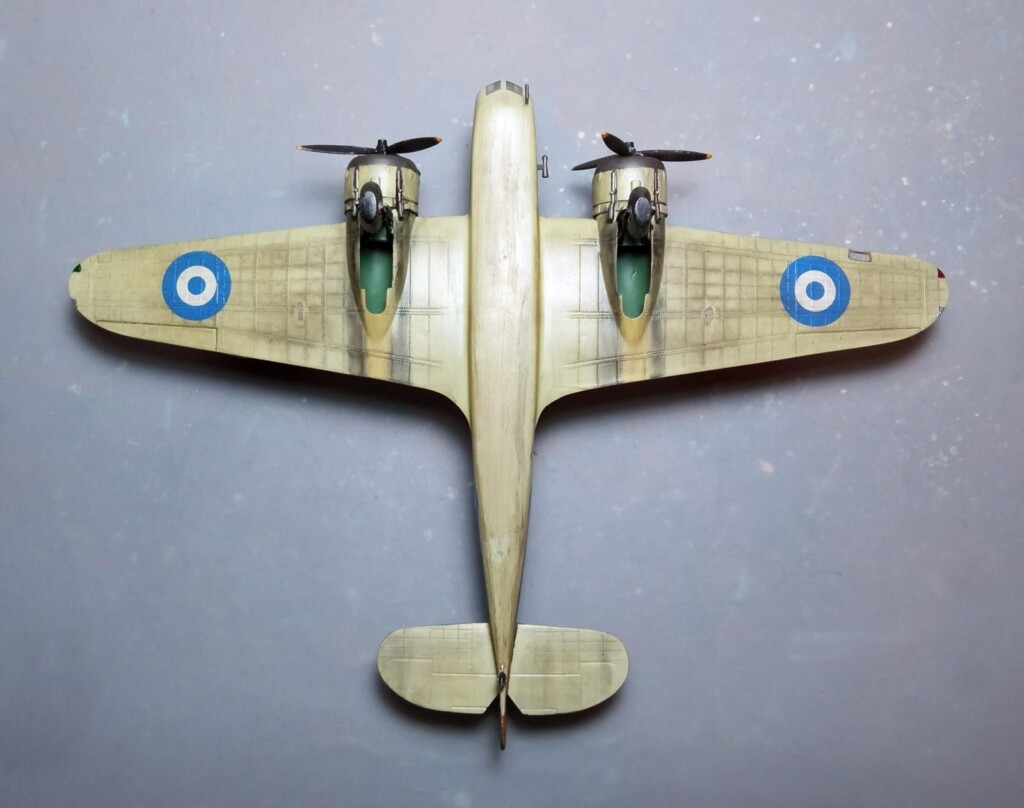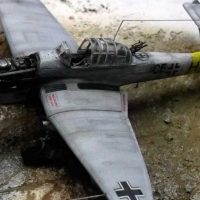Airfix 1/72 Bristol Blenheim IV
The development of the Blenheim began when the Bristol Type 142, a civil airliner that first flew in April 1935, impressed with its performance, with the Air Ministry ordering a modified design as the Type 142M for the RAF as a bomber. Deliveries of the newly named Blenheim Mk.I commenced on 10 March 1937.
It was one of the first British aircraft with an all-metal stressed-skin construction, retractable landing gear, flaps, a powered gun turret and variable-pitch propellers.
In addition to operating as medium bombers, both versions were converted into heavy fighters by the addition of a gun pack with four Browning .303 in (7.7 mm) machine guns mounted under the fuselage and proved effective in the night fighter role.
Prior to the war, the successful implementation of a front bombardier / navigator position on the MkI, which resulted to the elongated MkIV, arose the interest of the Royal Hellenic Air Force (Ελληνική Βασιλική Αεροπορία - ΕΒΑ), which wanted the Blenheim to be its primary bomber. Cost negotiations delayed the order and when this was finally given for 24 units, time was running out and half were seized by the RAF.
The twelve received were delivered, perhaps not surprisingly,without operational equipment (no bomb sight, non conforming bomb attachment points and so on) and only the ingenuity of the technicians managed to make them combat-worthy and put to intensive use upon the outbreak of the war.
Acknowledging the fact that rapid technical advances deemed the type obsolete as a front line machine quicker than anticipated, the Blenheim was nevertheless a sound and effective design, particularly taking into account that it had not been designed from scratch, but practically emerged from a passenger layout evolving to a fighter/bomber.
This is the old Airfix, its origins traced in the late 60's. A basic kit, compared to today's standards. let alone compared to the modern superb Airfix offering. Still, an acceptable model can be made out of this elderly fellow.
Should you wish to read the full build review, you may do so by visiting my beloved site Modelingmadness:
https://modelingmadness.com/review/allies/gb/bombers/penblen.htm
Happy Modelling!

















Dear Spiros @fiveten, a beautiful build of a somewhat ugly bird! I like the exhaust staines on the underside a lot!
Thanks my friend @fxrob!
We’ll done, my friend Spiros, you’ve done a great job bringing this pensioner back from retirement, as did the Hellenic engineers making the original planes battle worthy.
Thanks my friend @chinesegeorge! The stories told about those greek planes' improvised bombsights (ie a purposefully "arranged" set of strings) due to the lack of a bombsight whatsoever, are really noteworthy!
Great job! A nice build of a challenging kit. Great history too. Thanks for sharing!
Thanks my friend @ferrw!
This is a fine looking Blenheim, Spiros @fiveten
Both, painting and weathering, are amazing, just like the rest of the build.
The historical article is a great addition. Thanks for sharing.
Thanks my friend @johnb!
Nicely done, Spiros. I like the weathering.
Thanks my friend @gwskat!
Absolute magic
What a treat for the eyes!
Thanks my friend @phyllyhiggpower!
Nice work on this, Spiros! I’ve become a bit of a Blenheim fan after building a few of the new Airfix kits in both 1/72 and 1/48.
I know the HAF also operated some Mk.Is. Would you happen to know a good source of information on these?
Thanks my friend @j-healy! Six Blenheim MkIs, sourced from the RAF, were received by the 32nd Bombardment Squadron as reinforcements following losses during operations on the Albanian front. The aircraft carried both schemes then in use with the British Air Force, the British serial numbers being replaced by B263 to B268. No plane was saved after the German invasion of Greece.
Thank you! That checks out with the few photos that I’ve found online. I’ve wanted to do one of them in the desert scheme. I’ve found photos of models that guys have made but no real info on them.
Nice work Spiros!
Thanks my friend @blackmopane!
A very acceptable build indeed! Nicely done Spiros.
Thanks my friend @roofrat!
Interesting bit of history . Amazing what could be done with just a few aircraft.
You did a great job on this old kit. Those older Airfix kits can be challenging .
Thanks my friend @ssgt!
Nice job on that old kit and an interesting history lesson!
Thanks my friend @chasbunch!
Another 'classic' kit classically done! Nice work Spiros!
Thanks my friend @georgeswork!
Another winner from a moldy oldie Spiros! I'm really hoping Airfix does this in 1/48.
Thanks my friend @dtravis! I too hope Airfix does a 1/48!
Raally cool kit! Very nice finish!
Thanks my friend @lis!
Well done, Spiros (@fiveten). Another winner, especially from the old Airfix kit. If anything, the extra rivets add to the character of the paint scheme.
Thanks my friend @gblair!
Spiros (@fiveten), nice work on that old beastie. I have an early box release of a Hudson 1 from Airfix that I plan to do someday , giving it the modern makeover treatment. I like taking these and doing that sort of stuff because it requires using scratch building skills which I don't need as much with today's kits.
Thanks my friend @clipper! I too love these kits for the same reasons you mentioned.
Another beauty! Well done!
Thanks my friend @gkittinger!
There is some life in the old kits, and you have it. Super job.
Thanks my friend @matthewfdyer!
Back from my vacation and just catching up. I like what you've done with the old kit, very nice research and great modelling skills.
Thanks so much, my friend @christopher!